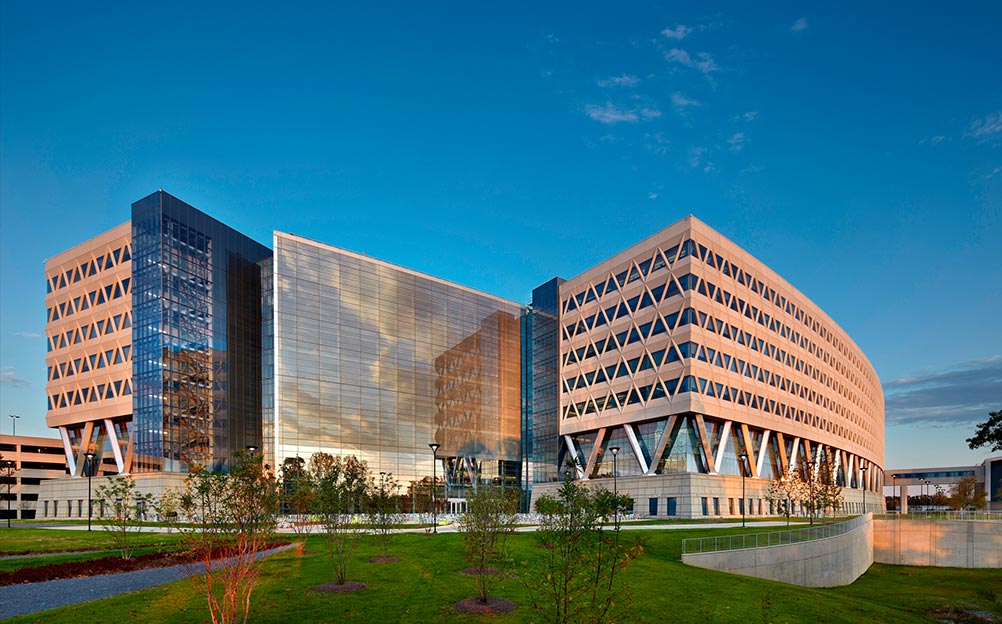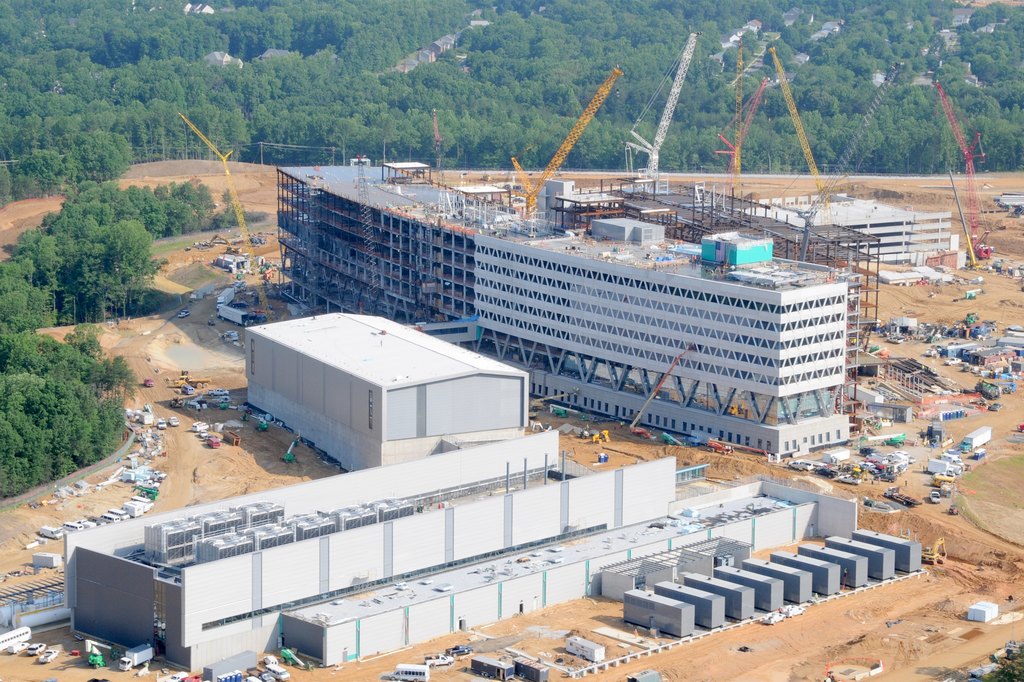Merit Shop Firms Collaborate to Deliver $1.4 billion Federal Project to USACE Without Government-Mandated Project Labor Agreement
The joint venture of Balfour Beatty Construction and Clark Construction on the National Geospatial-Intelligence Agency (NGA) Campus East Headquarters at Fort Belvoir, Virginia, epitomizes successful partnering and delivery of a complicated large-scale federal construction project. These merit shop titans collaborated to build the largest U.S. Army Corps of Engineers (USACE) project since the Pentagon and the third largest government building in the D.C. Metropolitan area.
Built without an anti-competitive and costly government-mandated project labor agreement (PLA), this $1.4 billion project demonstrates what the federal government already knows about merit shop contractors: They provide value to taxpayers with on-time, on-budget and safe construction projects.
From 2001 until it was repealed by President Obama’s Feb. 6, 2009, pro-PLA Executive Order 13502, President George W. Bush’s Executive Orders No. 13202 and 13208 ensured there were no government-mandated PLAs on $147 billion worth of federal construction projects and hundreds of billions of dollars of federally assisted construction projects, saving taxpayers billions of dollars and providing opportunities for qualified contractors and their skilled employees.
Research found there were no labor-related problems on federal projects as a result of a lack of PLA mandates and PLA requirements, which typically increase the cost of construction between 12 percent and 18 percent, on average, when compared to similar projects built without a PLA mandate.
It was just as true then as it is now: There is no justification for government-mandated PLAs.
Unfortunately, in exchange for political support from Big Labor, lawmakers typically steer taxpayer-funded construction contracts to well-connected firms employing unionized workers via these crony contracting PLA schemes.
This impressive NGA project demonstrates how taxpayers benefit when federal contracting is not corrupted by backroom deals.
A Challenging Mega-Project
In 2005, as mandated by the Base Realignment and Closure Commission (BRAC), the NGA faced a formidable task of consolidating 8,500 employees and six regional branches into one large, state-of-the-art headquarters campus. To make the task more daunting, the NGA had to complete the merge by the Congressionally-mandated deadline of September 15, 2011. In order to be successful, the finished product needed to provide a modern work facility, technology center for highly sensitive government data, separate utility plant to power the campus and comforts of a 21st century work environment.
Facing time and budget constraints, Clark and Balfour Beatty Construction (CBB) joined the project at 15 percent design completion and gained control of the contract at 35 percent design completion. CBB and USACE used an integrated design-bid-build (IDBB) process – a new form of contractor involvement that partners the public and private sectors at the early stages of a project.
The NGA Campus East (NCE) is a mega-project in every sense. The entire mission was broken into five interconnected parts: the main office building, technology center, central utility plant, parking structure and visitors center. The main office building, which stands as the centerpiece of the campus, is an eight story, 2.2 million-square-foot facility that has a footprint equal to two aircraft carriers. It measures four football fields long and is made from 22,500 tons of steel and 52,000 cubic yards of concrete.
The technology center acts as the brain of the NCE – it houses 1,400 IBM servers that enable information processing of 16,000 work stations in the main office building. The center is 150,000 square-feet and includes a pedestrian bridge and utility tunnel that connects to the main office building.
The central utility plant is responsible for powering the entire NGA campus; it includes chilled water systems, emergency power generation and a boiler plant. An innovative dual-temperature system chills water and directs it to beams to cool the data center, producing 45 percent in regulated energy savings.
In order to complete such a massive undertaking, CBB and the project’s partners relied on a collaborative approach to deliver this project. Partnering meetings with key stakeholders were held weekly, twice-monthly and monthly by the respective levels of the three-tiered project leadership structure. These meetings allowed the entire team to address project issues, anticipate risks and identify which parts of the project were most successful.
When the project was complete, it was clear the new headquarters would benefit moral and increase productivity of all those stationed there. In what used to take a one-hour car ride, staffers can now hold collaborative meetings in a simple trip down the stairs. The new facility also includes a dry cleaner, credit union, state-of-the-art fitness facility and even a beauty salon. CBB increased the amount of natural light the entire building received in a way that did not compromise security – something many employees were not used to.
Sustainability & Safety
From the start, the CBB Joint Venture and the NGA Headquarters project team set out to build an environmentally friendly and sustainable facility. It was originally designed for LEED Silver but after working with the owner and design team, CBB achieved LEED Gold certification. With 86.8 percent of the generated construction waste being recycled and 45 percent regulated energy savings, the headquarters is now the largest new federal LEED construction project.
Safety was a primary focus throughout the entire NGA project. In March 2010, the entire planning team set a goal of zero recordable and zero lost-time incidents. By implementing a strict zero tolerance policy on site, CBB was able to achieve their goal and, at one point, went more than two million man hours without a single lost-time incident. Management even implemented an “equipment rodeo” where ground personnel sat in the chairs of heavy machine operators to demonstrate blind spots and remind workers about constant vigilance.
Recognition
Clark and Balfour Beatty received numerous awards and accolades for their work on the NGA East Headquarters.
The project was awarded the highest level of recognition in the mega-projects category at Associated Builders and Contractors’ (ABC) 23rd Annual Excellence in Construction Awards. At Associated General Contractors’ (AGC) annual convention the project was awarded the Marvin M. Black Excellence in Partnering Award. The National Capital Region of the United States Green Building Council named it Project of the Year.
Michael J. Rogers, Program Manager for USACE Baltimore, commended CBB for, “achieving the objective of completely moving 8,500 workers from other facilities in Washington, D.C., into the new facility by the Base Realignment and Closure Act deadline, all while maintaining 100 percent continuity of their critical national security mission.”
Letitia Long, the director of NGA, was impressed with the detailed steps taken by CBB, “We never used to have windows in our old facilities…That’s a big morale booster right there.” She also spoke about the positive responses she has received from NGA employees, “They love this commute here. This was one of the best sites that could have been chosen among the rest of the sites that were considered.”
The outstanding work of Clark Construction and Balfour Beatty Construction on the NGA Campus East Headquarters is a shining example of what merit shop contractors and their employees can produce with an unwavering commitment to safety, hard work and collaboration, via fair and open competition.













